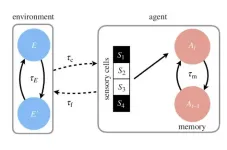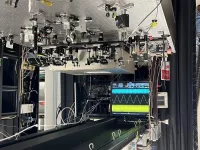(Press-News.org) They say a picture is worth a thousand words.
A new method, developed by University of Michigan researchers, creates images that are worth many gigabytes of data, which could revolutionize the way biologists study gene expression. Seq-Scope, developed by Jun Hee Lee, Ph.D., Hyun Min Kang, Ph.D., and their colleagues, was first described in Cell in 2021 as the first method to analyze gene expression at sub micrometer-scale spatial resolution.
To compare, a single human hair ranges from 20 to 200 micrometers in width.
The team has since improved Seq-Scope, making it more versatile, scalable, and accessible, which was just published in Nature Protocols. Additionally, the same group has developed an algorithm for analyzing high-resolution spatial data from Seq-Scope and other technologies, called FICTURE, described in Nature Methods.
“Basically, we are hacking DNA sequencing machines and letting them do all of the hard work,” said Kang, a professor of biostatistics with the U-M School of Public Health.
Researchers use these machines to produce readouts of the transcriptome, the collection of all RNA transcribed from genes with a given cell or tissue.Traditionally, biologists studying genes within a cell or tissue must contend with the fact that a transcriptome has tens of thousands or more genes expressed, too much to make heads or tails of without the help of a computer when it also involves millions of cells.
“The problem is traditionally, there are no computational methods that allow us to understand this data set at microscopic resolution,” said Lee, a professor of Molecular & Integrative Physiology at U-M Medical School.
Lee and Kang’s proof-of-concept method, Seq-Scope demonstrated that a sequencing machine can be repurposed to profile spatially resolved transcriptomes, enabling scientists to see how and where a gene is expressed at microscopic resolution.The team subsequently has made Seq-Scope even more cost effective, reducing the cost of high-resolution spatial transcriptome profiling from upwards of $10,000 to around just $500.
Furthermore, the new FICTURE method enables investigators to analyze massive amounts of data, by pooling the surrounding data together to make a more accurate inference at the micrometer level. By doing so, they demonstrate, you can see where cell transcripts are located without any bias.
The method generates incredibly detailed images of tissues and cells from its microscopic resolution analysis.
For example, with traditional analysis, “even if you have cell segmentation, if you don’t know exactly which cells are being transcribed and stained, the analysis can be misleading or unclear,” said Kang.
“Using FICTURE, for example, you can see that skeletal muscle tissue from a developing mouse embryo is differentiating into long striated muscle cells from myoblasts.”
“We’re getting a lot of emails from companies and other investigators who previously assumed they wouldn’t be able to do such experiments and analyses. Now they are in the realm of possibility,” said Lee.
U-M’s Advanced Genomics Core co-authored the Seq-Scope protocol paper, contributing by optimizing the use of DNA sequencers. The facility is now working to make the Seq-Scope method even more accessible, aiming to disseminate this technology to U-M and the broader scientific community.
"This is exactly the kind of technology we want to bring to as many labs as possible, both here at U-M and beyond," said AGC Director Olivia Koues, Ph.D.
“Our goal is to empower more researchers with cutting-edge spatial transcriptomics capabilities.”
Lee and Kang next hope to develop a way to make the method even more accessible to researchers, enabling them to study genomic expression from beginning to end.
Said Kang, “I think it’s important for computational and experimental investigators to work together to generate new types of data and methods. This is a good example of that type of collaboration.”
END
A newly developed algorithm shows how a gene is expressed at microscopic resolution
2024-10-31
ELSE PRESS RELEASES FROM THIS DATE:
Why elephants never forget but fleas have, well, the attention span of a flea
2024-10-31
Researchers at the Complexity Science Hub and Santa Fe Institute have developed a model to calculate how quickly or slowly an organism should ideally learn in its surroundings. An organism’s ideal learning rate depends on the pace of environmental change and its life cycle, they say.
Every day, we wake to a world that is different, and we adjust to it. Businesses face new challenges and competitors and adapt or go bust. In biology, this is a question of survival: every organism, from bacteria to blue whales, faces the challenge of adapting to environments that ...
Childhood neglect associated with stroke, COPD, cognitive impairment, and depression
2024-10-31
Toronto, ON, – New research from the University of Toronto found that childhood neglect, even in the absence of childhood sexual abuse and physical abuse, is linked with a wide range of mental and physical health problems in adulthood.
“While a large body of research has established the detrimental impact of childhood physical and sexual abuse on adult health outcomes, much less is known about whether neglect, in the absence of abuse, has similar negative outcomes,” said first author, Linxiao Zhang, a PhD student at the Factor-Inwentash Faculty of Social Work (FIFSW) at the University of Toronto. “Our research underlines the importance of health professionals ...
Landmark 20-year study of climate change impact on permafrost forests
2024-10-31
In perhaps the first long-term study of CO2 fluxes in northern forests growing on permafrost, an Osaka Metropolitan University-led research team has found that climate change increased not only the sources of carbon, but also the CO2 sinks.
The 20-year observation from 2003-2022 in the interior of Alaska showed that while CO2 sinks turned into sources during the first decade, the second decade showed a nearly 20% increase in CO2 sinks.
Graduate School of Agriculture Associate Professor Masahito Ueyama and colleagues found that warming led to wetness, which in turn aided the growth of black spruce trees. During photosynthesis, the growing trees were using the increasing ...
Researchers take broadband high-resolution frequency combs into the UV
2024-10-31
WASHINGTON — Researchers have developed a new ultrafast laser platform that generates ultra-broadband ultraviolet (UV) frequency combs with an unprecedented one million comb lines, providing exceptional spectral resolution. The new approach, which also produces extremely accurate and stable frequencies, could enhance high-resolution atomic and molecular spectroscopy.
Optical frequency combs — which emit thousands of regularly spaced spectral lines — have transformed fields like metrology, spectroscopy and precision timekeeping via optical atomic clocks, earning the 2005 Nobel Prize in Physics.
The ...
Not going out is the “new normal” post-Covid, say experts
2024-10-31
Compared with just before the Covid-19 pandemic, people are spending nearly an hour less a day doing activities outside the home, behaviour that researchers say is a lasting consequence of the pandemic.
A new study published in the peer-reviewed Journal of the American Planning Association reveals an overall drop since 2019 of about 51 minutes in the daily time spent on out-of-home activities, plus an almost 12-minute reduction in time spent on daily travel such as driving or taking public transportation.
The analysis, based on a survey of 34,000 Americans, ...
Study shows broader screening methods help prevent spread of dangerous fungal pathogen in hospitals
2024-10-31
Study Shows Broader Screening Methods Help Prevent Spread of Dangerous Fungal Pathogen in Hospitals
Screening high-risk patients for Candida auris allows for early detection and implementation of infection control measures to prevent hospital outbreaks
Arlington, Va. — October 31, 2024 — A new study published today in the American Journal of Infection Control (AJIC) describes the outcome of a shift in hospital screening protocols for Candida auris, a dangerous and often drug-resistant fungal pathogen that spreads easily in hospital environments. A comparison of screening results and patient outcomes before ...
Research spotlight: Testing a model for depression care in Malawi using existing medical infrastructure
2024-10-31
How would you summarize your study for a lay audience?
We tested a model of depression care in Malawi, a low-income country in sub-Saharan Africa, that builds off the infrastructure of the country’s HIV delivery system. The intervention involved clinical officers who delivered medications for depression, and it involved lay personnel, people living in the community, to deliver psychotherapy. Unlike past research, we did not limit our evaluation to improvements in depression; we also looked at improvements in other chronic health conditions that participants had, and we measured effects on household members.
What knowledge gap does your study help to ...
Depression care in low-income nations can improve overall health
2024-10-31
Treating people in low-income countries for major depressive disorder can also help improve their physical health and household members’ wellbeing, demonstrating that mental health treatments can be cost effective, according to a new RAND study.
Researchers examined a program in the sub-Saharan nation of Malawi that builds off the infrastructure of the country’s HIV care system and trains local people in rural communities to help treat people who suffer from depression.
The study found participants had significant improvements in their depression symptoms, ...
The BMJ investigates dispute over US group’s involvement in WHO’s trans health guideline
2024-10-30
The World Health Organization (WHO) says that it is adhering to standard protocol in pursuing its transgender health guideline, but the process has been criticised for lacking transparency and an association with WPATH - an organisation that supports the “gender affirming” approach, including hormones and surgery, for all ages - and is under fire for meddling with its own guideline development.
In The BMJ today, freelance journalist Jennifer Block investigates these concerns and the questions they raise about how evidence based the panel’s recommendations would be.
Earlier ...
Personal info and privacy control may be key to better visits with AI doctors
2024-10-30
UNIVERSITY PARK, Pa. — Artificial intelligence (AI) may one day play a larger role in medicine than the online symptom checkers available today. But these “AI doctors” may need to get more personal than human doctors to increase patient satisfaction, according to a study led by researchers at Penn State. They found that the more social information an AI doctor recalls about patients, the higher the patients’ satisfaction, but only if they were offered privacy control.
The research team published their findings in the journal Communication Research.
“We tend to think of AI doctors as machines ...


